Centauri Dreams
Imagining and Planning Interstellar Exploration
Disk Imagery from Nearby Young Stars
Here’s an interesting situation: Around a star designated GSC 07396-00759, a member of a multiple star system, astronomers have found an edge-on disk. Such disks are helpful ways of studying planetary evolution, as we’re looking at gas, dust and planetesimals that represent a planetary system in the process of formation. But at GSC 07396-00759, the disk is more evolved than the gas-rich disk around the T Tauri star in the same system. In other words, we have two stars evidently of the same age whose disks show a different evolutionary pace.
Elena Sissa (INAF-Osservatorio Astronomico di Padova) is lead author of a new paper on this find, in press at Astronomy & Astrophysics. The paper puts the matter this way:
Even if there is no “smoking gun” proof, the system characteristics all together tend to favor an evolved/debris disk nature for GSC 07396-00759 over a primordial/gas-rich disk. If confirmed, this is a very interesting discovery since this star and V4046 Sgr form a coeval physically bound system that would consist of a gas-rich circumbinary disk and a debris disk. Therefore it is of paramount importance to search for gas in the GSC 07396-00759 disk.
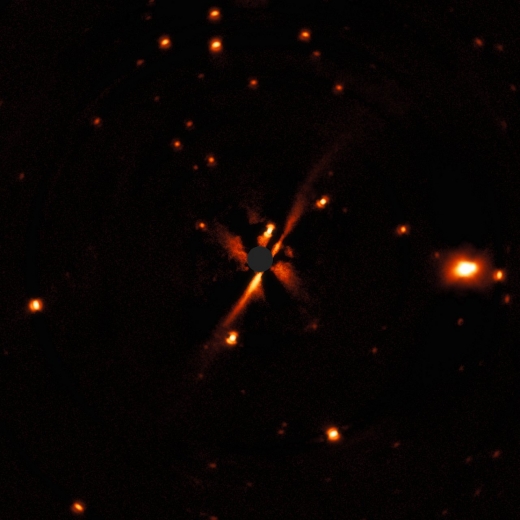
Image: This SPHERE observation is the discovery of an edge-on disk around the star GSC 07396-00759, which is a member of a multiple star system included in the DARTTS-S sample. Oddly, this new disk appears to be more evolved than the gas-rich disk around the T Tauri star in the same system, although they are the same age. The disk extends from the lower-left to the upper-right and the central grey region shows where the star was masked out. Credit: ESO/E. Sissa et al.
Such finds highlight the reasons we study disks in the first place, to learn more about how planetary systems emerge. And we’re now getting new images from the SPHERE instrument mounted on the European Southern Observatory’s Very Large Telescope in Chile that show us discs in more detail than ever before. SPHERE stands for Spectro-Polarimetric High-contrast Exoplanet REsearch instrument, a planet finder whose primary job is to do direct imaging of gas giants around nearby stars, but one that’s also fine-tuned for turning up protoplanetary disks.
In the image below, we’re looking at T Tauri stars, which are less than 10 million years old and varying in brightness. Our early Solar System may well have looked something like the disks we see here. A survey called the DARTTS-S (Discs ARound T Tauri Stars with SPHERE) produced most of this work, though the GSC 07396-00759 find came from a different survey effort; both used SPHERE to produce their images. The targets are all relatively near, ranging from 230 to 550 light years from Earth.
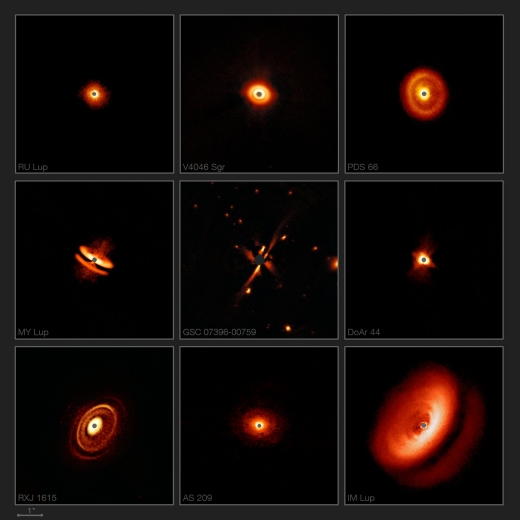
Image: New images from the SPHERE instrument on ESO’s Very Large Telescope are revealing the dusty discs surrounding nearby young stars in greater detail than previously achieved. They show a bizarre variety of shapes, sizes and structures, including the likely effects of planets still in the process of forming. Credit: ESO/H. Avenhaus et al./E. Sissa et al./DARTT-S and SHINE collaborations.
The SPHERE imagery also takes in a target previously investigated by the Atacama Large Millimeter/submillimeter Array (ALMA), which found two rings of material within the disk surrounding the Sun-like star IM Lupi. Both rings are made up of heavy ions in the form of DCO+ (deuterium, carbon, oxygen). Here I turn for background to work by Karin Öberg (Harvard-Smithsonian Center for Astrophysics) and colleagues, who studied the IM Lupi disk’s chemistry and published a 2015 paper on the matter. Says Öberg:
“With ALMA we can directly observe this chemistry in discs that are right now in the process of making planets. The molecules have formed two spectacular rings. The inner one we expect to see; the outer one comes as a complete surprise and sheds new light onto the properties of a protoplanetary disc’s outer reaches.”
For more on this unusual disk, see Surprising chemistry seen in molecular rings around young star, an article in Astronomy Now. SPHERE now offers IM Lupi’s unusual disk in striking detail.

Image: This spectacular image from the SPHERE instrument on ESO’s Very Large Telescope shows the dusty disk around the young star IM Lupi in finer detail than ever before. Credit: ESO/H. Avenhaus et al./DARTT-S collaboration.
The images of T Tauri star disks were presented in a paper entitled “Disks Around T Tauri Stars With SPHERE (DARTTS-S) I: SPHERE / IRDIS Polarimetric Imaging of 8 Prominent T Tauri Disks”, by H. Avenhaus et al., to appear in in the Astrophysical Journal (preprint). The discovery of the edge-on disk is reported in a paper entitled “A new disk discovered with VLT/SPHERE around the M star GSC 07396-00759”, by E. Sissa et al., to appear in the journal Astronomy & Astrophysics (preprint).

Exoplanets: Accelerating the Pace of Discovery
As we await the launch of the Transiting Exoplanet Survey Satellite, I want to pause this morning to remind everyone of another significant mission: CHEOPS (CHaracterising ExOPlanet Satellite). The decade ahead is going to be an exciting one for exoplanet discovery, given that we have TESS about ready to go, JWST in the pipeline despite its problems, and CHEOPS expected to launch in 2019. Eleven European nations are involved in CHEOPS, a European Space Agency ‘S-class’ mission that will study exoplanetary transits.
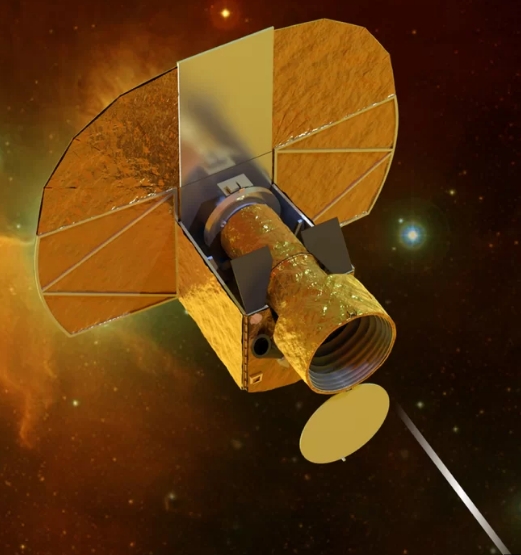
Image: Artist’s impression of CHEOPS at work. Credit: ESA.
In 2026, we can look forward to ESA’s PLAnetary Transits and Oscillations of stars (PLATO) mission, which will study up to a million stars in search of planetary transits, with the emphasis on rocky planets in the habitable zone. In 2028, we have the ARIEL mission (Atmospheric Remote-sensing Infrared Exoplanet Large-survey) to anticipate (see ARIEL: Focus on Exoplanet Atmospheres). What a run of space-based photometric discovery lies ahead.
We’ve been studying exoplanet transits from space since 2006, when the CoRoT mission launched. CoRoT examined two fields of view, each containing several thousand dwarf stars with magnitudes ranging from 11 to 16. In its five years of operations, the mission discovered, among several dozen exoplanets, a planet designated CoRoT-7b, which turned out to be the first exoplanet identified as having a rocky core.
Kepler expanded the field by measuring brightness variations to an accuracy of order 20 ppm in a single field of view of approximately 100-square degrees, and continues to function in its remarkable K2 extended mission. We’ve been tracking developments in the thousands of Kepler confirmed and candidate exoplanets since the mission began. Now CHEOPS will target bright stars to provide a large sample of small planets with well-measured radii, enough to provide the density information we need as we probe deeper into planet formation and evolution. Both missions will feed prime exoplanet targets to our anticipated JWST.
CHEOPS will use an optical telescope with an aperture of 30 cm inserted into a Sun-synchronous orbit about 800 kilometers above the Earth, with a mission duration of 3.5 years. Synergies between CHEOPS and TESS should be apparent, with CHEOPS delivering precise radius information on targets identified by the earlier mission. The photometric precision CHEOPS achieves should be similar to Kepler’s, while observing brighter stars located anywhere on the sky and targeting small exoplanets already found by radial velocity methods as well as transiting Neptune-class worlds that have been detected by ground surveys.
This morning comes news that construction of CHEOPS has been completed, with engineers from the Center for Space and Habitability (CSH) at the University of Bern packaging the instrument for delivery to Madrid, where it will be integrated to the satellite platform. Airbus Defense and Space in Spain built the satellite platform and will supervise testing of the integrated spacecraft in coming weeks. At the conclusion of various further rounds of testing, the spacecraft will be sent to Kourou in French Guiana, from which it will be launched in 2019 by a Soyuz rocket.
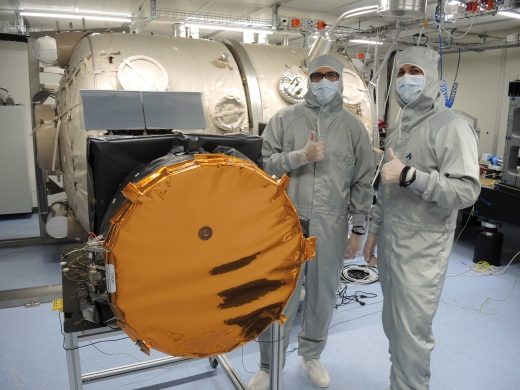
Image: The CHEOPS telescope in the cleanroom of the University of Bern. Credit: Thomas Beck / Universität Bern.
As the first mission designed to follow-up previous planetary discoveries around bright stars, a primary goal is to pick out those exoplanets most suitable for further investigation, particularly those whose atmospheres may be suitable for analysis. Planners hope that CHEOPS will be able to provide radii of unprecedented accuracy in those cases where ground measurements have provided a value for the planet’s mass, allowing the calculation of planetary density. Beyond choosing targets for further spectroscopic analysis, the telescope will also be used to examine Neptune-class planets and study the atmospheres of ‘hot Jupiters.’
With TESS taking the baton from Kepler, CHEOPS to follow, then PLATO and ARIEL, we are looking at all but continual dedicated exoplanet missions into the 2030s, perhaps 30 years from CoRoT through PLATO, as my friend Ashley Baldwin has reminded me in a recent email. Bear in mind that this time period will also see the emergence of the extremely large telescope (ELT) class of instrument on the ground. A golden age of discovery goes into accelerated mode.

A Triton Lander Mission
What would be our next step in the exploration of the outer system once New Horizons has visited one or more Kuiper Belt objects (KBOs)? One intriguing target with a nearby ice giant to recommend it is Triton, Neptune’s unusual moon, which was imaged up close only once, by Voyager 2 in 1989. The views were spectacular but at the time of the encounter, most of Triton’s northern hemisphere remained unseen because it was in darkness. Only one hemisphere showed up clearly as the spacecraft passed the moon at a distance of 40,000 kilometers.
Our next visit should tell us much more, but we’re still working out the concept. Thus Steven Oleson’s Phase II grant from NASA’s Innovative Advanced Concepts (NIAC) office. Oleson (NASA GRC) calls the idea Triton Hopper. In his Phase I study, he identified the various risks of the mission, analyzing its performance and its ability to collect propellant. For Triton Hopper — moving from point to point — would rely on a radioisotope engine that would collect nitrogen ice and use it for propellant, mining the moon’s surface to keep the mission viable.
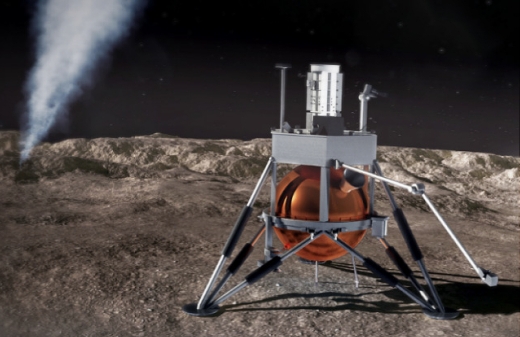
Image: Graphic depiction of Triton Hopper: Exploring Neptune’s Captured Kuiper Belt Object. Credit: S. Oleson.
Triton is interesting on a number of levels, one of which has received recent examination As with other outer system moons, we’re learning that there may be a liquid ocean beneath the crust. Let me quote a short presentation from Terry Hurford (NASA GSFC) on this:
There is compelling evidence that Triton should be considered an ocean world. Fractures observed on Triton’s surface are consistent in location and orientation with tidal stresses produced by the decay of Triton’s orbit as it migrates toward Neptune. Tidal stresses can only reach levels to fracture the surface if a subsurface ocean exists; a solid interior will result in smaller tidal stress and likely no tectonic activity. Tidal stresses therefore provide a mechanism for fracturing and volcanism analogous to activity observed on Enceladus and, possibly, Europa. Given that Triton’s interior has dissipated a tremendous amount of energy as heat, which likely drove differentiation, and that this heat may remain until the present day, an energy source likely exists to drive geologically recent activity. Moreover, it is possible that tidal volcanism has facilitated, if not dictated, the expression of this activity on Triton’s surface.
Triton’s surface seems to be in geological motion, given how few craters show up in the Voyager views. We can also factor in that this is the only large moon in the Solar System with a retrograde orbit, leading to the view that it is a captured dwarf planet from the Kuiper Belt. That nitrogen that Steven Oleson wants to use should be abundant at the surface, with a mostly water-ice crust to be found below. Also of considerable interest: Triton’s surface deposits of tholins, organic compounds that may be precursor chemicals to the origin of life.
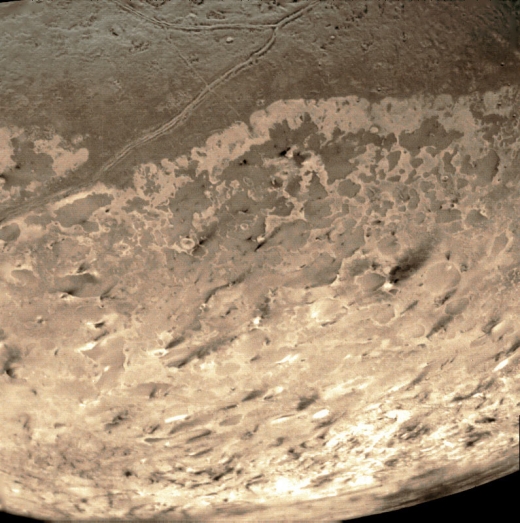
Image: Triton’s south polar terrain photographed by the Voyager 2 spacecraft. About 50 dark plumes mark what may be ice volcanoes. This version has been rotated 90 degrees counterclockwise and artificially colorized based on another Voyager 2 image. Credit: NASA/JPL.
Geologically active places like Triton are intriguing — think of Io and Europa, Enceladus and Titan — and we can add Triton’s nitrogen gas geysers into the mix, along with its tenuous nitrogen atmosphere. No question a lander here would offer abundant science return. Oleson proposes heating that surface nitrogen ice under pressure and using it as a propellant that would allow a continuing series of ‘hops’ as high as 1 kilometer and 5 kilometers downrange. Thus we would get images and videos while aloft, and surface analysis while on the ground.
Intriguing. The thin atmosphere and even the geysers could be sampled by a Triton Hopper in the same way we have looked at the Enceladus plumes, by passing directly through them.
Working with GRC colleague Geoffrey Landis, Oleson presented Triton Hopper last year at the Planetary Science Vision 2050 Workshop in Washington DC. The thinking is to land near the south pole in 2040, in the area where geysers have already been detected. The surface can then be explored in as many as 60 hops, covering some 300 kilometers. Using in situ ices as propellants offers a uniquely renewable potential for mobility.
Oleson’s Phase II work will cover, in addition to mission options to reach Triton and descend to the surface in about 15 years, details of safe landing and takeoff of the hopper. Propellant gathering is obviously a major issue, one that will be explored through a bevameter experiment on frozen nitrogen (a bevameter can measure the properties of a surface in terms of interaction with wheeled or tracked vehicles). Also in play: How to collect and heat the nitrogen propellant and find ways to increase hop distance, solutions that could play into other icy moon missions.
Be aware, too, of a Phase II grant to Michael VanWoerkom (ExoTerra Resource), who will be studying in situ resource utilization (ISRU) and miniaturization. VanWoerkom’s NIMPH project (Nano Icy Moons Propellant Harvester) will deepen his investigation into mission refueling at destination, producing return propellant on site. The work thus complements Triton Hopper and deepens our catalog of strategies for sample return from a variety of surfaces.
The NASA precis for Oleson’s Phase II study is here. The NIMPH precis is here. The Hurford presentation is available as Hurford et al., “Triton’s Fractures as Evidence for a Subsurface Ocean,” Lunar and Planetary Science XLVIII (2017) (full text), but see as well Should we reconsider our view on Neptune’s largest moon?, which ran at Astronomy.com.

Laser Beaming and Infrastructure
Looking at John Brophy’s Phase II NIAC award reminds us how useful the two-step process can be at clarifying and re-configuring deep space concepts. Brophy (Jet Propulsion Laboratory) had gone to work in Phase I with a study called “A Breakthrough Propulsion Architecture for Interstellar Precursor Missions.” The work studied a lithium-fueled ion thruster with a specific impulse of 58,000 seconds. If that didn’t get your attention, consider that the Dawn spacecraft’s ISP is 3,000 seconds, and think about what we might be able to do with that higher figure.
I think about ideas like this in terms of infrastructure. The relation to interstellar flight is this: While we may well get robotic nano-probes off on interstellar missions (think Breakthrough Starshot) some time this century, the idea of human expansion into the cosmos awaits the growth of our civilization into the rest of the Solar System. Along the way, we will learn the huge lessons of closed-loop life support, means of planetary protection and propulsion technologies to shorten trip times. Building that infrastructure is an early phase of the interstellar project.

What Brophy has been working on with his Phase I study is the question of how to provide power to craft at the outer edge of our planetary system. When I looked at the 2017 NIAC awards, a stumbling block for Brophy seemed to be the need for a 10-kilometer laser array.
Brophy’s idea was to beam power to a lightweight photovoltaic array aboard the actual spacecraft — this is how he generates the power needed to drive those ion thrusters. Closer to home we would use solar power to do the trick today, while looking at nuclear power when far from the Sun. Brophy is talking about ion thruster operation in deep space without the need for a heavy onboard power source. This gets around the problem of increasingly inefficient solar panels as we go further from the Sun, as well as their alternative, a bulky nuclear reactor.
Image: John Brophy (JPL) initiated the NSTAR Project that provided the ion propulsion system for Deep Space 1, delivered the ion propulsion system for the Dawn mission, and co-led the study at Caltech’s Keck Institute that resulted in the Asteroid Redirect Mission. His Phase II NIAC award will be used to investigate beamed power delivery to a powerful ion engine. Credit: JPL.
If we can power up the lithium-ion engine, mission velocities of 100 to 200 km/s would be possible. This is exciting stuff: The Phase I study talked about a 12-year flight-time to 500 AU, which gets us into gravitational lensing territory, while flight time to distant Pluto/Charon could be reduced to 3.6 years. For that matter, imagine a Jupiter mission in roughly a year.
A 10-kilometer array is daunting indeed, but now we’re going into Phase II, which significantly refines the concept based on the results of the Phase I study. Phase I assumed a 100 MW output power at a laser frequency of 1064 nm, feeding a 70 MW electric propulsion spacecraft with a 175-meter photovoltaic array coupled to its lithium-fueled ion thrusters.
What the Phase I study revealed was a better set of parameters: Brophy will begin the Phase II study with a laser array of 2-kilometer diameter aperture with an output power of 400 MW at a laser frequency of 300 nm. Aboard the vehicle, a 110-meter diameter photovoltaic array is now considered. It will power a 10 MW electric propulsion system.
Results of the Phase I work brought the specific impulse down to 40,000 seconds, which is the figure of merit for Phase II, all in the service of a specific mission outcome: A journey to the solar gravity focus at 550 AU. The changes in configuration came from feasibility analysis — could we develop the required photovoltaic arrays with the required areal density (200 g/m2)? Could we achieve photovoltaic cells tuned to the laser frequency with efficiencies greater than 50%? And what about pointing the laser array with the needed accuracy, not to mention stability to supply the reference mission at the gravity focus?
In terms of beamed propulsion, Brophy’s laser array should remind us of Breakthrough Starshot’s own plans for such an array, though Starshot does not plan on building the array in space. Starshot’s array is to be on the ground, avoiding the huge issue of constructing and controlling a gigantic laser outside our planet, while creating a host of other questions, such as atmospheric attenuation of the laser signal. In both instances, however, we deal with a power source separate from the spacecraft, producing real benefits in terms of weight and efficiency, and creating a reusable driver for missions throughout the system.
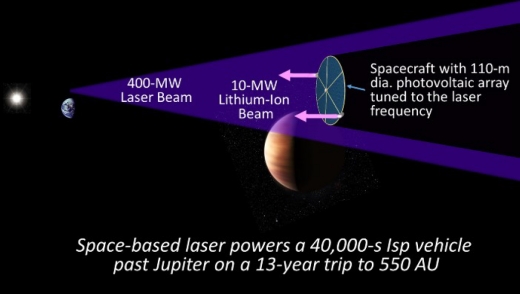
Image: Graphic depiction of A Breakthrough Propulsion Architecture for Interstellar Precursor Missions. Credit: J. Brophy.
And what about the power developed in the onboard photovoltaic array? The output in the Phase I study was expected to be 12 kV, which goes a long way beyond the best solar arrays available today. Those on the International Space Station, for example, produce 160 volts. One part of Phase II, then, will be to show that the photovoltaic system can be operated at more than 6 kV in the plasma environment produced by the lithium-ion propulsion system.
Have a look at the precis to see what Brophy considers to be the outstanding technical issues, which include modeling the lithium plasma plume created by the engine and demonstrating a small aperture phased array that can become scalable to larger apertures. Depending on the outcome of these investigations, a roadmap should emerge showing how we might develop demonstrator missions along the way to finalizing a workable system architecture.
Let’s put all this into perspective. The challenge of operating beyond 5 AU is the rapid dropoff in solar power available to a spacecraft, despite recent advances in photovoltaic array technology. A laser system like Brophy’s could increase the power density of photons available to a spacecraft bound for the outer Solar System by several orders of magnitude, giving us an ion propulsion system of considerable power. Moreover, this would be a spacecraft that does not need to create its own power but receives it, doing away with power processing hardware.
I come back to infrastructure when evaluating concepts like this. A workable laser array of this magnitude becomes a way to solve power issues far from the Sun that could drive missions throughout the system. Like the combined laser / neutral particle beam concept we’ve looked at over the last two days, it assumes a hybrid meshing of technologies that could go a long way toward enabling robotic and manned missions deep into the Solar System. That makes laser beaming to an ion engine an alternative well worth the continued scrutiny of NIAC Phase II.

Tightening the Beam: Correspondence on PROCSIMA
Yesterday’s post on PROCSIMA (Photon-paRticle Optically Coupled Soliton Interstellar Mission Accelerator) has been drawing a good deal of comment, and I wanted to dig deeper into the concept this morning by presenting some correspondence between plasma physicist Jim Benford, a familiar face on Centauri Dreams, and PROCSIMA’s creator, Chris Limbach (Texas A&M Engineering Experiment Station). As we saw yesterday, PROCSIMA goes to work on the problem of beam spread in both laser and particle beam propulsion concepts.
In my own email exchange with Dr. Limbach, he took note of the comments to yesterday’s Centauri Dreams article, with a useful nod to a concept called ‘optical tweezers’ that may be helpful. So let me start with his message of April 4, excerpting directly from the text:

I took a quick glance at the comments, and I see that the laser guiding (i.e. waveguide) effect is fairly well understood, but the guiding of the particles is less clear. I admit this is the less intuitive aspect and the weak interaction requires special consideration in the combined beam design. But to give a general sense, we are taking advantage of the same effect as optical tweezers (https://en.wikipedia.org/wiki/Optical_tweezers) except applied on the level of atoms instead of nanoparticles. That is, the atoms in our neutral beam are drawn to the high intensity region because they can be polarized.
I hope your readers are as excited about this project as I am!
Personally, I do find the project exciting because I’ve been writing about the problems of keeping a laser beam collimated for an interstellar mission ever since I began digging into Robert Forward’s papers back around the turn of this century. You may remember the vast Fresnel lens that Forward proposed in the outer Solar System as a way of collimating the laser beam for interstellar use. Avoiding such colossal feats of engineering would be a welcome outcome!
We’ve examined the pros and cons of particle beams in these pages as well, learning that there is controversy over the question of whether neutral particle beams would not likewise be subject to beam spread. Geoff Landis has argued that “…beam spread due to diffraction is not a problem,” while Jim Benford has offered a strong disagreement. See yesterday’s post, as well as Beaming to a Magnetic Sail.
The PROCSIMA idea combines a neutral particle beam and a laser beam to eliminate beam spread and diffraction in both. If it can be made to work, it seems to offer long periods of acceleration for beamed interstellar sails and high delta-V. An Alpha Centauri mission with a flight time of about 40 years becomes possible with a spacecraft reaching 10 percent of the speed of light. Dr. Limbach had been discussing the idea with plasma physicist Benford before the NIAC Phase I award was granted, and they engaged in further correspondence about the idea shortly after.
Here is an excerpt of a Benford message from last August with regard to PROCSIMA. The paper he refers to is a fleshed out and much more detailed version of Jim’s Sails Driven by Diverging Neutral Particle Beams, which ran in these pages in 2014. It has been accepted at the Journal of the British Interplanetary Society, where publication is expected this fall:
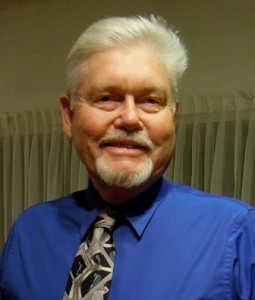
Chris: I made more revisions on my paper than I had expected, and submitted it to JBIS last night. It is attached.
On your laser tweezers idea, I assume the wavelength of the laser will be much much larger than the size of the atoms. So you will treat their interaction as electric dipoles in the electric field of the laser. What intensities of laser would you need in order to defeat the divergence of such a beam? The beams themselves will probably be on the order of 10 cm-1 m in diameter and so the laser beam will be of comparable size, I suppose.
Of course, the introduction of a powerful laser adds a complexity to the overall system, but the remarkable focus that you are expecting would be very interesting to see.
I will keep your idea to myself, but I’m sure that the community, in particular Gerry Nordley, Adam Crowl and Geoff Landis, would be very interested to hear about it.
By the way, there is at a meeting that’s entirely relevant to this, in October in Huntsville Alabama. It’s the Tennessee Valley Interstellar Workshop, which expects to have about 200 people attending. I attach their newsletter. Unfortunately, they don’t do streaming, so one has to attend to hear the talks!
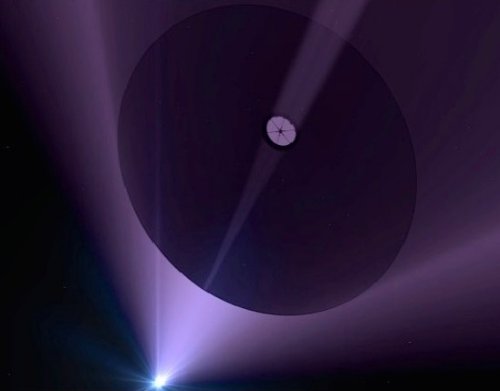
Image: Beamed propulsion leaves propellant behind, a key advantage. Coupled with very small probes, it could provide a path for flyby missions to the nearest stars. PROCSIMA studies the possibility that the problem of beam spread can be resolved. Credit: Adrian Mann.
Chris Limbach was unable to attend the TVIW meeting, but he replied to Benford in a message on August 15:
Thank you for your quick reply. My timing was fortuitous! Also, thank you for offering to send an updated version of your forthcoming paper.
I would like to hold this concept closely until I submit the full proposal, but I will describe the general outline. I only ask that you do not share with anyone in the near-term.
Essentially, I have discovered that a neutral particle beam and high intensity laser beam can be combined in such a way as to simultaneously eliminate the problems of diffraction and beam divergence. This is possible because of physical mechanisms that 1) attract atoms into regions of high optical intensity (i.e. toward the center of the laser beam) and 2) provide an optical focusing effect in regions of high atom density (i.e. toward the center of the neutral beam). If these two effects can be balanced then both the neutral beam and laser beam will propagate, together, without any divergence. After running the numbers, I believe a spot size of 5 meters could be maintained over several astronomical units (!).
I am still concerned that higher-order effects will cause problems, but I believe the basic numbers work out and the concept warrants further investigation/optimization. I am interested in your paper because the neutral beam divergence will place fundamental constraints on certain parameters (e.g. particle density, laser beam intensity, …) for this concept.
After the August messages, the correspondence ended until news of the recent NIAC funding, about which Dr. Limbach informed Jim Benford, leading to my own conversation with Jim and agreement with both scientists that this correspondence could be reproduced to help clarify aspects of the PROCSIMA project. As I mentioned yesterday, there are two levels of funding at NIAC, with PROCSIMA currently receiving Phase I funding. After Phase I’s initial definition and analysis, a Phase II grant can be applied for to develop the concept further.
We’ll await the completion of the Phase I study with great interest, given that a successful PROCSIMA would deliver the best of both the laser and neutral particle beam ideas, while removing one of their biggest problems. If it works, this idea should be readily scalable, pointing to its uses in fast missions throughout the Solar System and interstellar precursors far beyond the heliosphere. The idea has to be shaken out through this initial NIAC work, but it is certainly gaining the attention of the beamed propulsion community.

PROCSIMA: Wedding Two Beam Concepts
The name Proxima will always have resonance with interstellar theorists given that our nearest target — and one with a potentially life-bearing planet at that — is Proxima Centauri. Thus an acronym with the same pronunciation is bound to catch the attention. PROCSIMA stands for Photon-paRticle Optically Coupled Soliton Interstellar Mission Accelerator, one of 25 early-stage technology proposals selected for Phase I funding by the NASA Innovative Advanced Concepts (NIAC) office. A number of Phase II proposals selected for funding was also announced.
These awards are always fascinating to watch because they’re chosen from a host of bleeding edge ideas, helping us keep a finger on the pulse of deep space thinking even if many of them end with their Phase I funding, $125,000 over nine months to produce an initial definition and analysis. Should the results be encouraging, Phase II funding becomes a possibility, ramping the money up to $500,000 over two years to encourage further development.
The 2018 Phase I competition involved over 230 proposals and just 25 winners, a tough selection process that resulted in a number of interesting proposals. NIAC works by fostering ideas from a wide range of scientists working outside NASA’s umbrella, as Jim Reuter, acting associate administrator of NASA’s Space Technology Mission Directorate, notes:
“The NIAC program gives NASA the opportunity to explore visionary ideas that could transform future NASA missions by creating radically better or entirely new concepts while engaging America’s innovators and entrepreneurs as partners in the journey. The concepts can then be evaluated for potential inclusion into our early stage technology portfolio.”
Creating a Tight Beam

We’ll have plenty to work with over the next few days, but I’ll start with PROCSIMA, which comes from Chris Limbach (Texas A&M Engineering Experiment Station), and points to the possibility of solving a tricky problem in beamed propulsion. Specifically, if you’re using a laser beam to push a sail, how can you reduce the spread of the beam, keeping it collimated so that it will disperse as little as possible with distance? A perfectly collimated beam seems impossible because of diffraction, thus limiting the length of time our sail can remain under acceleration.
Image: Texas A&M’s Christopher Limbach. Credit: Texas A&M.
Particle beams, which actually offer more momentum per unit energy than laser beams, likewise tend to diverge, although as we’ve seen in earlier articles, the nature of the divergence is problematic (see the contrasting views of Jim Benford and Geoff Landis on the matter, as in Beaming to a Magnetic Sail). Particle beams might turn out to be just the ticket for fast in-system transportation as far out as the Oort Cloud, while being limited because of beam spread when it comes to interstellar applications. That makes divergence an issue for both types of beam.
But I should quote Geoff Landis (NASA GRC) first, because he thinks the neutral particle beam problem can be surmounted. Landis works with mercury in his example:
[Thermal beam divergence] could be reduced if the particles in the beam condense to larger particles after acceleration. To reduce the beam spread by a factor of a thousand, the number of mercury atoms per condensed droplet needs to be at least a million. This is an extremely small droplet (10-16 g) by macroscopic terms, and it is not unreasonable to believe that such condensation could take place in the beam. As the droplet size increases, this propulsion concept approaches that of momentum transfer by use of pellet streams, considered for interstellar propulsion by Singer and Nordley.
Benford sees the divergence problem as fundamental. Charged beams would interact, spiraling around each other to produce transverse motion that creates beam divergence. Neutral particle beams would seem to be the ticket if Landis is right, but Benford sees three problems. Let me quote him (from Sails Driven by Diverging Neutral Particle Beams; a JBIS paper on these matters has been accepted for publication but is not yet available):
First, the acceleration process can give the ions a slight transverse motion as well as propelling them forward. Second, focusing magnets bend low-energy ions more than high-energy ions, so slight differences in energy among the accelerated ions lead to divergence (unless compensated by more complicated bending systems).
Third, and quite fundamentally, the divergence angle introduced by stripping electrons from a beam of negative hydrogen or tritium ions to produce a neutral beam gives the atom a sideways motion. (To produce a neutral hydrogen beam, negative hydrogen atoms with an extra electron are accelerated; the extra electron is removed as the beam emerges from the accelerator.)
Reducing the first two causes of beam divergence, Benford believes, is theoretically possible, but he sees the last source of divergence as unavoidable, nor does he accept Gerald Nordley’s idea of reducing neutral particle beam divergence through laser cooling. And he finds Geoff Landis’ idea of having neutral atoms in the particle beam condense (see Landis citation below) to be unlikely to succeed. Are our beaming strategies hopelessly compromised by all this?
PROCSIMA tries to get around the problem by combining a neutral particle beam and a laser beam, a technique that, according to Chris Limbach, could prevent spread and diffraction in both kinds of beam. Let me quote him from the NIAC description:
The elimination of both diffraction and thermal spreading is achieved by tailoring the mutual interaction of the laser and particle beams so that (1) refractive index variations produced by the particle beam generate a waveguide effect (thereby eliminating laser diffraction) and (2) the particle beam is trapped in regions of high electric field strength near the center of the laser beam. By exploiting these phenomena simultaneously, we can produce a combined beam that propagates with a constant spatial profile, also known as a soliton.

Image: Graphic depiction of PROCSIMA: Diffractionless Beamed Propulsion for Breakthrough Interstellar Missions. Credit: C. Limbach.
An interesting concept because it draws from recent work in high-energy lasers as well as high-energy neutral particle beams, producing a hybrid notion that seems worth exploring. In his precis on PROCSIMA, Limbach says he believes this beamed propulsion architecture would increase the probe acceleration distance by a factor of ~10,000, allowing us to send a 1 kg payload to Proxima Centauri at 10 percent of lightspeed, making for a 42-year mission.
We watch laser developments with interest particularly with regard to Breakthrough Starshot, which assumes a similar high-energy laser capability in the 50 GW range. Starshot is an investigation into nano-scale payloads carried by small beamed sails to nearby stars. Can we tap neutral particle beam technology to achieve increased delta-V, solving the diffraction problem at the same time? As Limbach points out, such technologies are a hot topic within the nuclear fusion community, which looks at heating magnetically confined fusion plasmas.
Expect more on this concept in short order. The Landis paper is “Interstellar flight by particle beam,” Acta Astronautica 55 (2004), 931-934. I’ll have a full citation on the Benford paper as soon as it is published.


